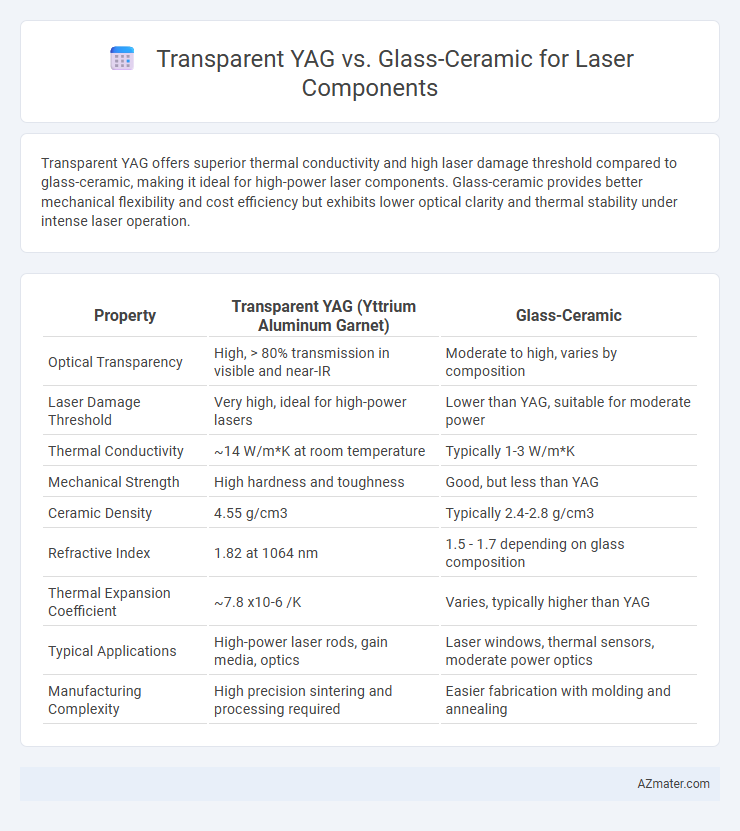Transparent YAG offers superior thermal conductivity and high laser damage threshold compared to glass-ceramic, making it ideal for high-power laser components. Glass-ceramic provides better mechanical flexibility and cost efficiency but exhibits lower optical clarity and thermal stability under intense laser operation.
Table of Comparison
| Property | Transparent YAG (Yttrium Aluminum Garnet) | Glass-Ceramic |
|---|---|---|
| Optical Transparency | High, > 80% transmission in visible and near-IR | Moderate to high, varies by composition |
| Laser Damage Threshold | Very high, ideal for high-power lasers | Lower than YAG, suitable for moderate power |
| Thermal Conductivity | ~14 W/m*K at room temperature | Typically 1-3 W/m*K |
| Mechanical Strength | High hardness and toughness | Good, but less than YAG |
| Ceramic Density | 4.55 g/cm3 | Typically 2.4-2.8 g/cm3 |
| Refractive Index | 1.82 at 1064 nm | 1.5 - 1.7 depending on glass composition |
| Thermal Expansion Coefficient | ~7.8 x10-6 /K | Varies, typically higher than YAG |
| Typical Applications | High-power laser rods, gain media, optics | Laser windows, thermal sensors, moderate power optics |
| Manufacturing Complexity | High precision sintering and processing required | Easier fabrication with molding and annealing |
Introduction to Laser Component Materials
Transparent YAG (Yttrium Aluminum Garnet) offers superior optical clarity and high thermal conductivity, making it ideal for high-power laser components requiring efficient heat dissipation and minimal signal distortion. Glass-ceramics provide excellent mechanical strength and resistance to thermal shock, often favored for applications needing durable laser windows and lenses with tailored thermal expansion properties. Both materials are crucial in laser technology, with Transparent YAG excelling in laser gain media and glass-ceramic enhancing structural stability and optical performance in laser systems.
Overview of Transparent YAG
Transparent Yttrium Aluminum Garnet (YAG) is a synthetic crystalline material renowned for its exceptional optical clarity and high thermal conductivity, making it ideal for laser components such as lenses and windows. Its cubic crystal structure provides excellent mechanical strength and resistance to thermal shock, outperforming many glass-ceramics in high-power laser applications. Transparent YAG exhibits minimal birefringence and high laser damage threshold, critical for maintaining beam quality and durability in precision laser systems.
Properties of Glass–Ceramic Materials
Glass-ceramic materials exhibit exceptional thermal stability, low thermal expansion, and high transparency, making them ideal for laser components requiring precise optical performance. Their unique microstructure provides enhanced mechanical strength and resistance to thermal shock compared to transparent YAG crystals. These properties enable glass-ceramics to maintain optical clarity and structural integrity under high-power laser operation and rapid temperature fluctuations.
Optical Performance: YAG vs Glass–Ceramic
Transparent YAG exhibits superior optical performance compared to glass-ceramic components, offering higher laser-induced damage thresholds and improved thermal conductivity, which enhances beam quality and stability. Glass-ceramics typically present lower scattering losses and are more cost-effective but suffer from reduced transmittance and higher birefringence, affecting laser precision. The choice between YAG and glass-ceramic hinges on application-specific demands for durability, optical clarity, and thermal management in high-power laser systems.
Thermal Conductivity and Management
Transparent YAG (Yttrium Aluminum Garnet) exhibits superior thermal conductivity of approximately 14 W/m*K, enabling efficient heat dissipation in high-power laser components and minimizing thermal lensing effects. In contrast, glass-ceramics typically have lower thermal conductivity around 1-3 W/m*K, which can lead to increased thermal gradients and reduced performance under intense laser operation. Effective thermal management in laser systems favors Transparent YAG due to its robust thermal properties, ensuring better stability and longevity compared to glass-ceramic materials.
Mechanical Strength and Durability
Transparent YAG exhibits superior mechanical strength and durability compared to glass-ceramic materials, making it ideal for high-stress laser components. Its high fracture toughness and thermal shock resistance provide enhanced longevity under intense laser operation conditions. Glass-ceramic, while offering decent optical clarity, generally falls short in mechanical robustness and long-term stability under high power densities.
Fabrication and Processing Techniques
Transparent YAG (Yttrium Aluminum Garnet) is typically fabricated using the Czochralski method, allowing precise control over crystal growth and resulting in high optical quality with minimal defects. Glass-ceramic laser components are produced through controlled crystallization of glasses, involving heat treatment that enables tailored microstructure and mechanical properties. Processing Transparent YAG demands high-temperature polishing and precise machining to maintain optical clarity, whereas glass-ceramics offer easier shaping but require stringent thermal management to preserve transparency and laser performance.
Cost Considerations and Scalability
Transparent YAG offers higher material costs due to complex crystal growth but ensures superior optical performance and durability for laser components. Glass-ceramic alternatives provide cost-effective manufacturing with simpler processing methods, enabling easier scalability for mass production despite slightly lower thermal and optical properties. Choosing between Transparent YAG and glass-ceramic involves balancing upfront expenses against long-term performance requirements and production volume demands.
Application Suitability: Transparent YAG vs Glass–Ceramic
Transparent YAG offers superior thermal conductivity and high damage thresholds, making it ideal for high-power laser components requiring precise beam quality and stability. Glass-ceramic materials provide excellent mechanical strength and lower thermal expansion, suitable for applications needing dimensional stability and complex shaping in moderate-power laser systems. Selection depends on balancing thermal management and mechanical requirements specific to the laser application's power and operational environment.
Future Trends in Laser Component Materials
Transparent YAG offers superior thermal conductivity and mechanical strength compared to glass-ceramic, making it ideal for high-power laser components requiring efficient heat dissipation. Glass-ceramic materials exhibit excellent optical homogeneity and customizable thermal expansion coefficients, allowing precision tuning for specific laser applications. Future trends emphasize hybrid materials combining YAG's robustness with glass-ceramic's adaptability to enhance laser performance and durability under extreme operating conditions.

Infographic: Transparent YAG vs Glass–ceramic for Laser component
 azmater.com
azmater.com